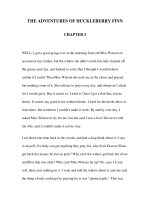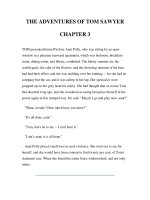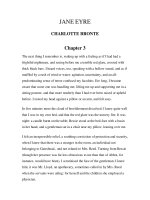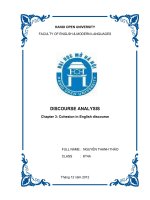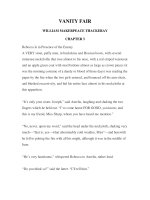earth science chapter 3
Bạn đang xem bản rút gọn của tài liệu. Xem và tải ngay bản đầy đủ của tài liệu tại đây (7.66 MB, 45 trang )
Chapter 5Chapter 4Chapter 3
The rocks of
Bryce Canyon
are called hoodoos.
How can we describe rocks
and soil?
Earth’s
Materials
CHAPTER 3
"MBCBNB)JMMT$BMJGPSOJB
126
Lesson 1
Rocks
Page 130
Lesson 2
Rocks Change
Page 140
Lesson 3
Soil
Page 150
2 ES 3. Earth is made of materials that have distinct
properties and provide resources for human activities.
127
Literature
Poem
by Aileen Fisher
In the middle of a meadow
we turned up a stone
and saw a little village
we never had known,
with little streets and tunnels
and ant-folk on the run,
all frightened and excited
by the sudden burst of sun.
ELA R 2.2.0. Students
read and understand grade-
level appropriate material.
128128128
We watched them rushing headlong,
and then put back the stone
to cover up the village
we never had known,
to roof away the tunnels
where ants were on the run . . .
before they got all sunburned
in the bright hot sun.
*6A@j 7DJIjI
What else could you
find under a rock?
129
boulders, Death Valley National Park, California
Rocks
Have you ever picked up a rock?
Scientists do, too. How do you
think scientists study rocks?
Lesson 1
2 ES 3.a. Students know how to compare the physical properties of different kinds
of rocks and know that rock is composed of different combinations of minerals.
130
ENGAGE
130
ENGAGE
How can we sort rocks?
What to Do
Observe. Look at your rocks
under a hand lens. Describe
what you see. How are they
alike? How are they different?
Classify. Put your rocks into
groups. Write your groups in a
chart. Record how many rocks
are in each group.
Explore More
Communicate. Share
your chart with a
partner. Discuss how
you put the rocks
into groups. What
other ways can you
classify rocks?
Step
You need
rocks
hand lens
2 IE 4.c. Compare and sort common objects according to two or
more physical attributes (e.g., color, shape, texture, size, weight).
131
EXPLORE
131
EXPLORE
Vocabulary
geologist
mineral
property
luster
hardness
How can we describe rocks?
A scientist who studies rocks is called
a
geologist . Geologists observe rocks to
identify different types. One thing they
look at is the color of the rock.
Many rocks are one color. Other rocks
are more than one color. Most rocks
are gray. Some are black, brown, red,
white, or even pink.
B What colors are these rocks?
chalk
gabbro basalt
132
EXPLAIN
Scientists look at the size
of rocks, too. Rocks that
are the same size might not
weigh the same.
shale
obsidian
mudstone
ironstone
pink granite
A These two rocks are the same
size. The pumice weighs less
than the malachite.
What are some things geologists
look at when they describe rocks?
133
EXPLAIN
What are rocks made of?
All rocks are made of minerals . Some
rocks are made of just one mineral.
Other rocks are made of many minerals.
Look at the piece of granite. It is
made up of three minerals. The white
parts are the mineral feldspar. The gray
parts are quartz. The black parts
are mica.
quartz
feldspar
mica
A Beryl is made of
only one mineral.
What are the minerals
in granite?
Read a Diagram
Minerals in Granite
134
EXPLAIN
Did you know that you use minerals
every day? Your pencil is made of
the mineral graphite. Plants use the
minerals in soil to help them grow.
Our bodies need minerals, too. We
get minerals from the foods we eat.
How do we use minerals?
fluorite
fluorite mine
A Some toothpastes have
fluoride, which is made
from the mineral fluorite.
135
EXPLAIN
How can we describe minerals?
A property tells you something about
an object. Color is one property of a
mineral.
Luster is another. Geologists
use the word luster to describe how a
mineral looks when light shines on it.
A Some minerals,
like quartz, shine
like glass.
A This halloysite does not
shine. It has a dull luster.
A Pyrite’s metallic luster tricks
some people into thinking
it is gold. This mineral is
also called fool’s gold.
136
EXPLAIN
1. Compare and Contrast. How are diamond
and granite alike? How are they different?
2. What are some ways we use minerals?
3. Write about the rocks you see every day.
Find different rocks outside. Make a sculpture
of them.
Another property of a
mineral is its
hardness .
Hardness is how tough a
rock is. Talc is so soft that
you can scratch it with
your fingernail. Diamond is
so hard that it can only be
cut by another diamond.
-Review Summaries and quizzes online @ www.macmillanmh.com
What are some properties
of minerals?
A Talc is the
softest mineral.
A Diamond is the
hardest mineral.
137
EVALUATE
Compare
When you compare, you look for ways
that things are alike and different.
Learn It
Cats meow and have four legs. Dogs
bark and have four legs. You can record
how cats and dogs are alike and different
in a Venn diagram. You write how the
animals are alike in the space where the
two circles meet.
2 IE 4.c. Compare and sort common objects according to two or
more physical attributes (e.g. color, shape, texture, size, weight).
138
EXTEND
feldspar
Try It
Look at the pictures below. Then try the skill.
1. How are feldspar and quartz alike?
How are they different?
2. Make a Venn diagram to compare
feldspar and quartz.
3.
Write About It. Find two other
rocks and compare them. Use a
Venn diagram.
quartz
139
EXTEND
Lesson 2
Rocks
Change
How do you think the Grand Canyon
was formed? How do you think these
rocks changed over time?
2 ES 3.b. Students know smaller rocks come from
the breakage and weathering of larger rocks.
140
ENGAGE
140
How can you change rocks?
What to Do
Observe. Look at rocks under a
hand lens. Describe what you see.
Put the rocks
in a jar of
water. Shake
the jar for two
minutes.
Explore More
Communicate. Look at the rocks
under a hand lens. How did the
rocks change?
You need
Step
rocks
hand lens
jar of water
2 IE 4.f. Use magnifiers or microscopes to
observe and draw descriptions of small
objects or small features of objects.
141
EXPLORE
141
Vocabulary
weathering
How do rocks change?
Most rocks are very hard, but did
you know that they can change size
and shape? The way water and wind
change rocks is called
weathering .
When water gets into the cracks of
rocks, it can freeze and push against
the rocks. The cracks get bigger and
then the rocks break.
Look closely at the rocks.
What do you think the water
is doing to them?
Read a Photo
Beach Rocks
Explore rocks
with the Treasure
Hunters.
Watch how rocks
change @ www.macmillanmh.com
142
EXPLAIN
granite arch, Sierra
Nevada, California
When rocks slide down
a hill, they may break
and become smaller.
The smaller rocks can
then break down into
sand. Tiny rocks can
become part of the soil.
How does weathering
change the shape
and size of rocks?
D Strong winds can blow
sand against rocks.
Wind and sand wore
this rock into an arch.
143
EXPLAIN
What other ways
can rocks change?
Weathering is not the only
thing that causes rocks to
change. Earthquakes can
change rocks, too. When
Earth shakes, rocks rub
against each other. They can
break into smaller pieces.
Plants can also change
rocks. Plants can grow in soil
inside the cracks of rocks.
Sometimes the roots are so
strong they cause the rocks
to break.
C The roots of this tree have
grown into the rock and
cracked it.
144
EXPLAIN
You know that rocks are made
of minerals. Water can cause
some minerals to change.
1. Compare and Contrast. Describe two ways
rocks can change.
2. What is weathering?
3. Write about how rocks can become part of soil.
Find rocks outside and sort them into groups.
Count how many are in each group.
-Review Summaries and quizzes online @ www.macmillanmh.com
A Water caused the copper
in this rock to turn green.
What are some ways rocks can change?
A A rock that has iron
will rust in water. It will
turn red and brown.
145
EVALUATE
Rock and Stroll
Rocks are all around us. We see them at the
beach and in the mountains. We see them in
gardens and on playgrounds. Go for a walk and
look at rocks. Take notes about the rocks you see.
Write About It
Write a letter to a friend. Write
about your walk. Describe the
rocks you saw. Explain how you
think they got their shape.
-Journal Write about it online @ www.macmillanmh.com
Remember
A letter shares
news with
someone.
ELA W 2.2.2. Write a friendly letter complete with the date,
salutation, body, closing, and signature.
146
EXTEND
Make a Pattern
Use rocks or draw pictures of
rocks to make a pattern. Share
it with a partner. Have your
partner explain what rock they
think will come next.
Rock Patterns
You can use rocks to make patterns. Look at
the pattern below. What kind of rock do you
think would come next? How do you know?
Remember
A pattern has a
unit that repeats.
?
MA SDAP 2.2.0. Students demonstrate an understanding of patterns
and how patterns grow and describe them in general ways.
147
EXTEND
Geologists at the American Museum of
Natural History travel all around the world
to collect rocks. There are thousands of
rocks in the museum. Some rocks are just
like the ones you might find in a park.
Other rocks are rare and strange!
hand lens
A
Some rocks that
come from a
beach are smooth.
Geologists use different tools to observe
rocks. They use a rock hammer to break
open a stone. Then they use a hand lens
to observe what is inside. They look at the
minerals that make up rocks. Scientists
can see how the rocks were formed. They
can find out where the rocks came from.
Geologists can tell if the rocks came from
a beach or a volcano.
A Azurite is a
rare rock.
rock hammer
ELA R 2.2.5. Restate facts and details in the text to clarify and organize ideas.
148
EXTEND
Science Technology and Society
C This geologist is using
a rock hammer.
*6A@j 7DJIjI
Compare and Contrast. How
are a beach rock and azurite
alike and different?
-Journal Write about it online
@
www.macmillanmh.com
149
EXTEND
